Casement vs Awning Windows: Which Offers Better Ventilation?
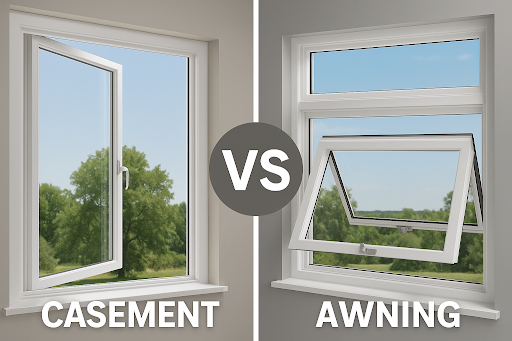
In terms of home ventilation, window choice really matters. Casement and awning windows are two most popular options out there.
Both are great, but casement windows offer slightly better airflow. They open wide like a door and catch side breezes easily. They’re perfect for cross ventilation and air circulation indoors.
Awning windows open upward and work well even during rain. But their design limits how much fresh air can come in.
For stronger airflow and better indoor air quality, casement wins. They’re also easier to position for natural ventilation in your home.
Stay tuned as we explore both to help you pick the right one!
What Is a Casement Window?
Casement windows are side-hinged and open outward like a door. They use a crank handle, which makes them easy to open wide.
Because they open fully, they let in lots of fresh air. These windows are often seen in modern and energy-efficient homes. They work great alone or in pairs for bigger openings.
They’re also tightly sealed when closed, which reduces air leaks and saves energy. Casement windows are popular for both airflow and clear outdoor views.
Key Benefits:
- Maximum Ventilation: Opens fully to bring in fresh, strong airflow.
- Controlled Airflow: You can angle them to catch breezes from outside.
- Better Energy Efficiency: Tight seal helps block drafts and keep temps steady.
- Great for Narrow Spaces: Fits well in tight or vertical wall sections.
- Unobstructed Views: No bar in the middle; just clean outdoor scenery.
- Secure Locking System: Multi-point locks add a layer of security.
Pros:
- Excellent for rooms that need strong ventilation
- Easy to open and close with a hand crank
- Helps lower energy bills due to tight seal
- Adds modern style to most home designs
Cons:
- Needs outdoor space to open fully
- Not ideal near walkways or decks
- Crank handles can wear over time
- Harder to use with window screens outside
Casement windows are ideal for homes that need top ventilation. They mix airflow, style, and energy efficiency. These windows are perfect for bedrooms, kitchens, and hard-to-reach spots.
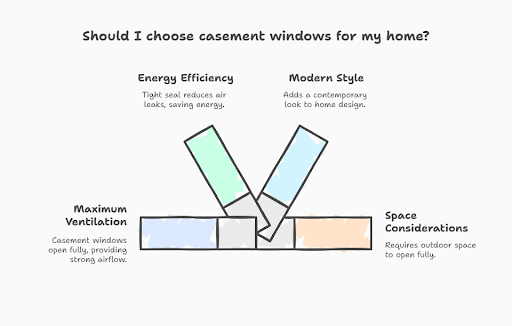
What Is an Awning Window?
Awning windows are hinged at the top and open outward from the bottom. They form an awning shape when open, which is how they got the name.
These windows allow airflow even when it’s raining outside. They work well high on walls or above doors and other windows.
Awning windows are commonly used in bathrooms, basements, and modern homes. You can open them using a crank, which makes them easy to operate.
Key Benefits:
- Ventilation During Rain: Slanted shape keeps rain out while letting air in.
- Energy Efficient: Seals tightly when closed to block drafts and leaks.
- Compact Design: Fits easily in tight spaces or higher wall areas.
- Privacy-Friendly: Works well in bathrooms or areas needing airflow and privacy.
- Combines with Other Windows: Often used above fixed or picture windows.
- Low Maintenance: Simple design means fewer parts to repair or replace.
Pros:
- Can stay open even during light rain
- Helps improve indoor air quality in small rooms
- Great for ventilation in basements and bathrooms
- Clean, modern look adds value to homes
Cons:
- Limited opening size compared to casement windows
- May not catch breezes as well in still air
- Harder to clean from the outside in multi-story homes
- Not ideal as an emergency exit
Awning windows are great for light airflow and rain protection. So, they are great for tight spaces and areas where privacy and air matter.
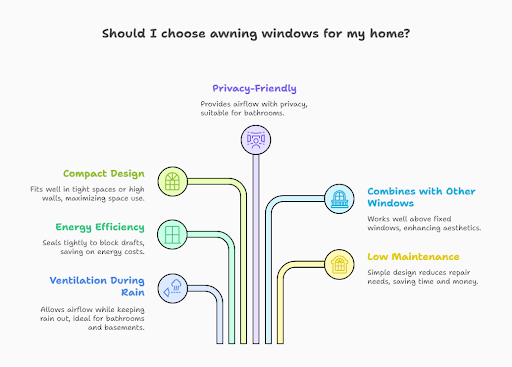
Comparing Casement vs Awning Windows
Both casement and awning windows help with natural ventilation. But they work differently and suit different needs and spaces. Let’s compare them side by side to see which fits best:
| Feature | Casement Windows | Awning Windows |
|---|---|---|
| Opening Direction | Hinged on side, opens outward like a door | Hinged at top, opens outward from bottom |
| Ventilation | Excellent airflow and breeze control | Good, but more limited |
| Rain Protection | Must be closed when raining | Can stay open during light rain |
| Ideal Location | Living rooms, bedrooms, main areas | Bathrooms, basements, above doors |
| Ease of Cleaning | Easy to clean from inside (ground floor) | Harder to clean from outside |
| Energy Efficiency | Very energy-efficient when closed | Also seals tightly when closed |
| Emergency Exit | Can double as an escape window | |
| Style | Traditional and elegant | Compact and modern |
| Airflow Direction | Catches side breezes easily | Limited, better for steady airflow |
| Cost | Slightly higher than awning | Usually more affordable |
Which Window is better for Home Ventilation
For home ventilation, casement windows are the better choice. They open wide like a door and catch side breezes. This design pulls in more air, and makes the room feel cooler and fresher.
Casement windows also help with cross ventilation, especially when placed across from each other. They’re great for bedrooms, living rooms, and large open areas.
Awning windows do allow airflow, but it’s more limited. They’re best for small spaces like bathrooms or basements.
If your goal is better air circulation and indoor freshness, casement windows offer stronger airflow and better ventilation overall.
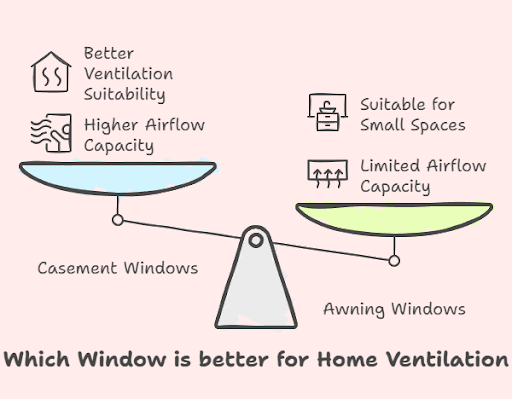
Which Window is Better For Energy Efficiency and Indoor Air Quality
Casement windows are better for both energy efficiency and indoor air quality. They close tightly with a seal that blocks outside air, which helps reduce energy loss.
That’s why they’re ideal for keeping your home warm in winter and cool in summer. Fewer air leaks mean lower energy bills and better control of indoor temperature.
For air quality, casement windows open fully, and allow more fresh air inside. It improves natural ventilation and removes indoor pollutants faster.
While awning windows also help, they don't open as wide. For overall efficiency and air quality, casement windows are the smarter choice.
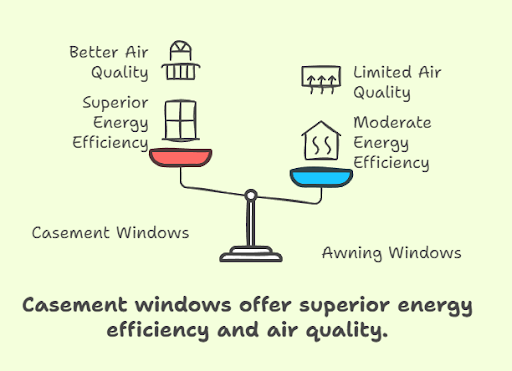
Conclusion
To wrap up, casement windows are the best windows for airflow and catching breezes. They work best in large rooms or where maximum ventilation is needed.
Awning windows are the best for smaller spaces or when it rains often. They allow light and air without letting water in.
So,
- If you want strong cross ventilation, go with casement windows.
- If you prefer light air, privacy, and weather protection, choose awning.











